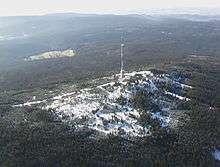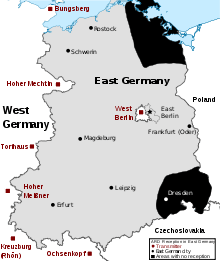Ochsenkopf Transmitter
The Ochsenkopf Transmitter (German: Sender Ochsenkopf) is a 163 metres (535 ft) radio and TV tower of reinforced concrete, which was built in 1958 on the summit of the 1,024 metres (3,360 ft) Ochsenkopf mountain, the second-highest mountain in the Fichtelgebirge mountain chain in Northern Bavaria, Germany. The tower replaced a 50 metres (160 ft) guyed steel tube TV mast that collapsed in January 1958 as result of icing. The tower, which is not accessible to the public, has a hyperbolic-shaped basement with five floors for technical equipment. Above it, there are platforms for directional antennas. The antennas for FM-transmission are on the upper part of the concrete tower, those for TV transmission on a steel tube mast on the top.

Transmitting to the former GDR

Ochsenkopf TV Tower played an important role in transmitting to the former GDR many West German FM and TV programs, notably ARD, West Germany's first – and between 1952 and 1963 only – television channel. Its signal could penetrate deep into the southern territory of East Germany due to its closeness to the border, its use of a low frequency (VHF Band I channel 4), and of vertical polarization. Under good conditions, its signal could be received as far away as Görlitz on the East German-Polish border, even though most aerials there were pointed at the West Berlin transmitters.
The transmitter required large and specifically mounted aerials nicknamed Ochsenkopf-Antenne, or Ochsenkopf for short, thus making the homes of viewers of western television easily recognizable. A campaign in the early 1960s by East Germany's state youth organisation FDJ aimed at turning away or removing such aerials exploited this fact.
Similar towers
Many other TV towers of similar design were built after 1958 in Germany and other European countries, including:
- Święty Krzyż TV Tower in Poland
- Brotjacklriegel TV Tower in Germany
- Donnersberg TV Tower in Germany
- Ještěd Tower in Czech Republic
- Schladming TV Tower, Austria
- Kitzbüheler Horn transmitter, Austria
- Mugel TV Tower, Austria
- Slanchev Bryag TV Tower, Bulgaria
- Stramni Rid TV Tower, Bulgaria
- Ostankino Tower in Moscow, Russia
Transmitted Programmes
FM Radio
| Program | Frequency | ERP |
|---|---|---|
| Bayern 1 | 90.7 MHz | 100 kW |
| Bayern 1 | 91.2 MHz | 20 kW |
| Bayern 2 Radio | 96.0 MHz | 100 kW |
| Bayern 3 | 99.4 MHz | 100 kW |
| DLF | 100.3 MHz | 100 kW |
| Bayern 4 Klassik | 102.3 MHz | 100 kW |
| Antenne Bayern | 103.2 MHz | 100 kW |
| B5 Aktuell | 107.1 MHz | 100 kW |
Television (analogue, PAL standard)
shut down on 30 Nov 2008
| Program | Frequency | ERP |
|---|---|---|
| ARD (BRF region) | Ch E4 vertical | 50 kW (used to be 100 kW) |
The public channels ZDF and Bayerisches Fernsehen for the region used to be transmitted from the nearby mountain Großer Waldstein.
Television (digital, DVB-T standard)
launched on 25 Nov 2008
| Channel | Frequency [MHz] |
Multiplex | Programme im Multiplex | ERP [kW] |
Antenna Diagram rund (ND) / gerichtet (D) |
Polarisation horizontal (H) / vertikal (V) |
Modulation | FEC | Guard Interval | Bit Rate [MBit/s] |
|---|---|---|---|---|---|---|---|---|---|---|
| E23 | 490 | ZDFmobil-Bouquet |
|
50 | ND | H | 16-QAM | 2/3 | 1/4 | 13.47 |
| E29 | 538 | ARD Bouquet | 100 | ND | H | 16-QAM | 2/3 | 1/4 | 13.47 | |
| E40 | 626 | BR-Bouquet |
|
100 | ND | H | 16-QAM | 2/3 | 1/4 | 13.47 |
See also
- List of towers